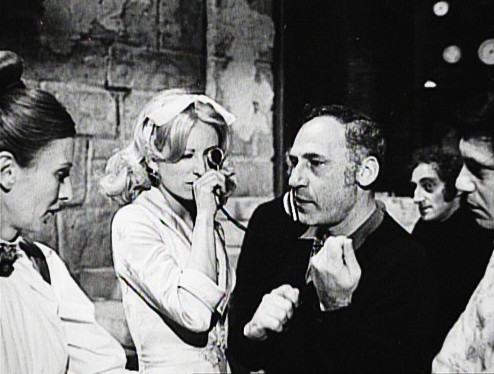
Beyond The Frame: Young Frankenstein
Gerald Hirschfeld, ASC on breaking the “rules” while shooting this black-and-white classic.

The horror-comedy Young Frankenstein (1974) — directed by Mel Brooks (in top image, at camera) and photographed by Gerald Hirschfeld, ASC (at right, gesturing over actor Peter Boyle strapped to the table) — was an instant classic, in part due to its uncanny recreation of the Expressionistic visual style made famous in the Universal Studios monster films of the 1930s, in particular, of course, Arthur Edeson, ASC’s camerawork in Frankenstein (1931) and John J. Mescall, ASC’s in Bride of Frankenstein (1935).

“[This picture] incorporated more photographic and special effects than any other film I've ever worked on,” Hirschfeld wrote in the July, 1974 issue of American Cinematographer magazine. “The range was tremendous, from trick candle effects to half-amillion-volt electrical discharges, from low-hanging fog to torrential rain. Chases, explosions and fire of past films seemed like child’s play by comparison. At first, I balked at the decision to do the film in black-and-white; suggesting that perhaps we start in black-and-white, as the film opens in old-time Transylvania, and then segue into color as we go to modern-day Baltimore to meet young Dr. Frankenstein [Gene Wilder].

“But the director [Brooks] was firm and I soon realized, as I progressed more into the feeling of the film, that he was 100% correct. I started my career making black-and-white films, and moved right along with the industry as color became the new medium. I’m sure you recall that television started in black-and-white and progressed technologically to color. Now, we are, in a sense, all victims of advertising and, at present, reject the use of black-and-white films as archaic.
“But where in the ‘book of rules’ does it say, ‘Make all motion pictures in color’? If it was correct, as it was many years ago, to use a ‘soft-focus’ lens for a close-up, we don’t arbitrarily throw that out in favor of one so critically sharp, as the new lenses are, that the skin pores will show; we add diffusion to once again soften the lens. Similarly, if it’s right for a story to be photographed in black-and-white, we shouldn’t arbitrarily shoot it in color.”
This creative choice would help make the picture a classic.






